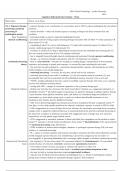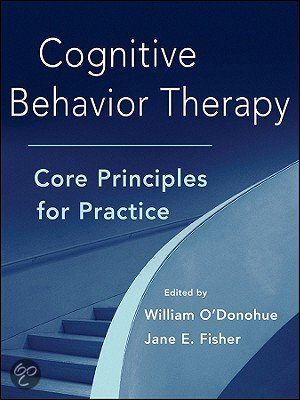MSc Clinical Psychology - Leiden University
2024
ognitive Behavioral Interventions - Notes
C
Main Topics Notes: Lec & Exam
h 4. Exposure therapy:
C - exposure therapy is not a mechanism, it's a procedure; used in CBT to reduce pathological fear and related
promoting emotional emotions
processing of - anxiety disorders = when safe stimuli acquires a meaning of danger and elicits irrational fear and
pathological anxiety avoidance
Basic Foundations - learning principles as used to understand pathological anxiety
classical conditioning - previously neutral CS (dog) acquires meaning through association with US (bite) → evokes automatic UR
(fear); forms CS → UR
- ispathologicalwhen CS is not in itself dangerous→ treated with extinction (repeat CS without US) or
counter conditioning (repeat CS with pleasant US)
- avoidance is reinforced via drop in physiological arousal; prevents the individual from learning that CS
does not entirely predict harm (CS-no US), impedes extinction!
- fear is originally learned through classical conditioning and maintained throughoperant conditioning
- therapy = a) extinction through confrontation with CS + b) elimination of avoidance
emotional processing - there is afear network= structure for escapingor avoiding danger; representation of feared stimuli,
theory responses, and meaning of stimuli and responses → activated by input matching the info stored
- fear structure becomespathological= associationsamong stimulus, response, and meaning do not reflect
reality (stimulus is not actually dangerous)
-emotional processing=correcting*the structure,which leads to fear reduction
- emotional processing occurs under 2 conditions: (1) the fear structure must be activated; (2) new
incompatible info must be incorporated into the pathological memory structure/ form a new one)
- *NOTE: actually, pathological structure cannot be modified, exposure therapy only formsa new competing
structure(see inhibitory learning theory)
- overlap with CBT = changes in erroneous cognitions is also a primary therapy goal
Empirical Evidence - phobias: fear structure has erroneous info about feared object/ situation, e.g., exaggerated estimation of
probability of harm → disconfirm negative expectations; no apparent advantage in adding cognitive therapy
- panic disorder: when physical sensations, panic, and anxiety are considered dangerous (indicators of
catastrophes e.g., heart attack, going crazy) → goal is to confront feared bodily sensations, in vivo;
medication may interfere (prevent inhibitory learning)
- SAD: worry about being judged and criticized, perceived as incompetent because of apparent anxiety →
role-plays, in vivo; make specific predictions for objective evaluation; exposure is critical in CBT for SAD
- GAD: exaggerations in a sense of harm, due to low tolerance for uncertainty, perceiving worry as positive
coping; worry is negatively reinforced (decrease in emotional distress) but prevents emotional processing in
the long-term; avoidance of situations associated with exaggerated sense of danger (e.g., new uncertain
experiences); no clear phobic target, limited success
- OCD: exaggerated or unrealistic estimates of threat and belief that compulsions are the needed to reduce
anxiety → exposure to feared stimuli and abstinence from rituals →disconfirmationof the expected harm
→
emotional processing; large effectiveness
- PTSD: avoidance of trauma-related thoughts, situations → prolonged exposure therapy (PE) has most
evidence → emotional processing
- PE = expose to trauma reminders and memories (avoidance maintains the beliefs about themselves and the
world); imaginal exposure (because even remembering is perceived as dangerous; but not under- or
over-engaged!) → processing immediately after, encourage explicit insights to facilitate emotional processing
Research and Unresolved - fear response to CS may return when: US is presented without CS (reinstatement); CS is presented
Issues outside the place of extinction (renewal); spontaneously(spontaneous recovery)
- avoid relapse: booster sessions; encourage to continue self-exposure on their own
- complicated grief: erroneous beliefs about death →avoidance preventing integration of loss
- also may be used in treating depression targetingexperiential avoidance
- exposure may be effective beyond reduction of pathological fear, i.e., whenever pathological emotions
arising from erroneous beliefs are maintained through cognitive/ beh avoidances
, h 2. Clinical
C - to empirically identify the controllable variables maintaining a behavior (functionally related)
Functional Analysis: - to personalize the intervention
Understanding the - to complement the current diagnostic system when the diagnostic doesn't entirely fit, treatment failed or
Contingencies of doesn't exist; an alternative to the "diagnose and treat" paradigm
Reinforcement -structuralism= focuses onunobservableinternalevents, via introspection
-functionalism= emphasis on theobservablebehavior;answer "why" by specifying contextual relationships
and how they influence the beh; assumes all beh to be adaptive and useful in some way
-behaviorism= primary goals is the prediction andcontrol of beh
- applied predominantly to treat observable beh in developmentally disabled, mood, SUD, eating, psychotic
- private/ internal events (e.g., emotions and thoughts) come under the same control as overt beh → also
apply to functional analysis
Distinguishing features -focus on the function/ purpose of beh rather thanits topography: through an analysis of the controlling
variables → can hypothesize how to change it!
- topography = descriptive features independent of the consequences; fail to explainwhythe beh is
occurring
-the unit of analysis is the whole personinteractingin and with a particular environment (beh cannot be
understood in isolation!, to also understand thefunctionof the beh)
-idiographic approach: examines beh on an individualbasis → identify targets relevant for the specific
client and contexts
-enhanced treatment utility of the assessment(howit helps with treatment outcomes) → FA is inherently
perspective!: indicates a specific and empirically supported course of action/ intervention!
-dynamic and iterative: FA is iterative and self-correctingin nature; ongoing processes of adapting the
prescribed intervention to new data from the beh and context
Basic behavioral principles -assumption: individual occurs within an environmentalcontext that interacts with the beh → this
interaction ="contingencies of behavior"
-one contingency = antecedents: behavior → consequences(it is three-term: A:B → C)
- A, B, C relate in a probabilistic manner (not mechanistic cause!);A increases the probability of B(set the
occasion for it),B produces C
-antecedents= environmental stimuli consistentlypresent in the context in which the beh occurs; grouped
intostimulus classes(= same effect on beh)
- emotions, thoughts (covert beh) are not considered as solitary antecedents (not in a vacuum)
-beh= anything an individual does (also privatee.g., emotions and thoughts); produce similar consequences
(=response classesof beh)
-consequences= changes in the environment afterthe beh that alter the probability of future occurrences
of the beh
-positive/ negativecontingencies = added/ removedstimulus from environment
-reinforcing/ punishingcontingencies = increase/decrease occurrence of beh
- use FA to know how a stimulus/ event affect future beh
Functioning relations -reinforcement: increase in the frequency of behavioras a function of the beh consequences; negatively
reinforced = stimulus taken away was apunisher
-punishment: decrease in the frequency of behavioras a function of the beh consequences; positively
punished =punisher
-extinction: a process thatbreaks the contingencybetween beh and its consequence; when beh no longer
produces a consequence; often precipitated by an extinction burst (= rapid increase in the frequency of the
beh before it decreases)
Guidelines for conducting - collaborate with the client to clearly formulate the concerns and to develop achievable goals
an FA Step 1: identify characteristics of the client through a broad assessment
- strengths e.g., personal resources; social support, financial…
- weaknesses e.g., diminished perspective taking, poor physical health…
- FA is a next step in assessment (after diagnosis) to investigate the function of the topographical beh
Step 2: develop preliminary analysis in terms of behavioral principles
- to determine the function of the beh
- assessment is limited to the controllable variables, identifying relationships that can be altered
- goal of FA= create an effective intervention linkeddirectly to the analysis of the beh
, Step 3: gather additional info and finalize the conceptual analysis
- describe the analysis as a working hypothesis that the clinician and client will test together
- evaluate the components of the analysis: interview relatives, conduct home-based assessments…
Step 4: devise an intervention based on step 3
- goal of intervention = modify the existing beh through (a) behavioral skills training, (b) alteration of
the environment, (c) modification of flawed rule statements affecting the beh
- Establishing alternative ways to engage with life via contingencies that support the new beh
Step 5: implement intervention and assess change(incorporatethe new data in the FA as it is collected)
Step 6: if outcome is unacceptable, recycle back to step 2 and 3
Limitations of FA - validity and reliability of FA has not been extensively evaluated
- requires time and resources → may be most cost effective when standardized interventions do not
effectively address all the causal variables, or when there is no evidence-based treatment available (often
with complex cases, i.e., multiple problems, variables)
h 9. Behavioral
C - "if there is one certainty in behavioral science,it is that positive reinforcement, when applied well, can generate,
activation (BA) change, and maintain behavior" → a scientific law
- positive reinforcement (R+) is fundamental to human experience
- to the behaviorist: contingencies indicate the meaning of the behavior
theprincipleof BA =therapeutic scheduling of specific activities forthe client to complete in daily life that function to increase contact
with diverse, stable, and personally meaningful sources of positive reinforcement
- scheduling of specific activities is primary component; also secondary techniques (see below)
- increase R+ is the ultimate goal; other techniques e.g., reducing escape and avoidance behaviors (negatively
reinforced) → increase R+ (it's a constructive therapy!, to create rich, meaningful lives)
- positive reinforcement as diverse, stable, and personally meaningful → not a hedonistic search for
pleasure! (the goal = the client's behavioral repertoire to be diverse, stable, and meaningful for the client!)
BA's model of
psychopathology
- depression begins with environments characterized by losses of, reductions in, or chronically low levels of
positive reinforcement (R+); e.g., loss of a loved one, loss of a job, chronic deprivation of R+ (abuse, neglect),
inability to obtain and maintain contact with R+ (e.g., social skills);
- depression can also begin with increased negative reinforcers (R-) → restricts the chance to experience R+
for fulfilling beh, e.g., financial stress, routine of "to-do's"; in a life dedicated to avoiding aversives (increased
R-), it is difficult to contact R+ (decreases R+ for positive behavior)
- many forms of psychopathology (depression, suicidal beh) are functions of unhealthy efforts to avoid
negative emotions, thoughts, memories, and social interactions → avoidance contributes to reductions in R+
- R+ of depressed behavior, e.g., family that gives room and covers for inactivity, appreciates being more at
home → healthy beh is not prompted, R+ is low
- reinforcement and mood covary together (anhedonia, negative mood, depression)
- reinforcement maintains behavior → lost R+ leads to reduction in the frequency or even extinction of
previous behavior/ activity
- increased R- and R+ for depressed behavior → increase in avoidance and depressed behavior → beh
changes the environment (reinforcement)
- clinical depression as a result of a self-perpetuating cycle of reinforcer, mood, and behavior changes
BA's theory of treatment
mechanism
- contingency management techniques alter the environment directly => target behavior to increase R+






